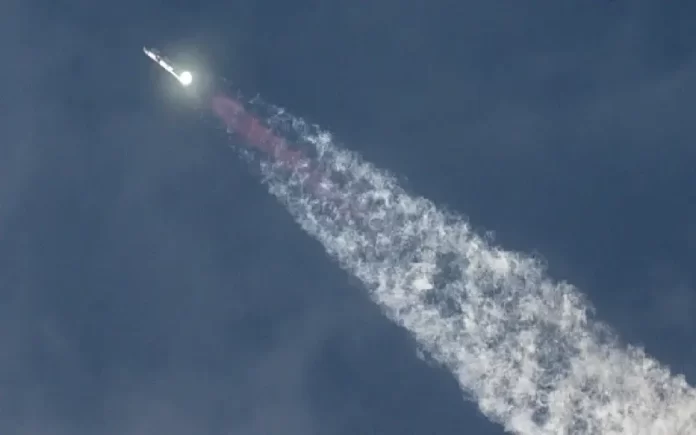Boca Chica, Texas: In a monumental leap forward, SpaceX’s Starship rocket embarked on its third test flight, marking significant advancements in the development of this colossal spacecraft.
Elon Musk’s aerospace company initiated the launch of Starship at approximately 9:25 a.m. ET from the Starbase facility near Boca Chica, Texas.
This flight achieved greater distances than its predecessors, with an anticipated hour-long journey culminating in a splashdown in the Indian Ocean.
Read More: Elon Musk Leaning Away from Biden for 2024 US Elections
Musk celebrated the milestone shortly after liftoff, announcing triumphantly, “Starship reached orbital velocity!”
Having undertaken two full-scale tests in the past year, SpaceX has been relentless in pushing the boundaries of innovation. While previous launches demonstrated promising advancements, they were marred by explosive outcomes. Despite these setbacks, SpaceX has remained undeterred in its pursuit of refining Starship into a fully reusable spacecraft capable of transporting cargo and passengers beyond Earth’s confines.
The Federal Aviation Administration granted clearance for this third launch attempt, underscoring the confidence in SpaceX’s iterative approach to development.
Read More: Tim Berners-Lee Envisions the Future of the Web: Potential Breakup of Big Tech Looms
Starship’s Magnificent Scale
Standing as the tallest and most powerful rocket ever launched, Starship, when fully assembled atop the Super Heavy booster, reaches a towering height of 397 feet, with a diameter of about 30 feet.
The Super Heavy booster, towering at 232 feet, propels the rocket on its voyage to space, powered by 33 Raptor engines generating an awe-inspiring 16.7 million pounds of thrust. This capability far surpasses NASA’s Space Launch System rocket.
Starship itself, measuring 165 feet tall, is equipped with six Raptor engines, optimized for both atmospheric and space travel, powered by liquid oxygen and liquid methane.
Read More: Microsoft CEO Satya Nadella Reflects on Google’s Potential Dominance in the AI Race
Goals for the Third Flight
This flight, devoid of human occupants, is aimed at surpassing previous milestones and validating critical capabilities. SpaceX seeks to extend the duration beyond the nearly eight-minute mark achieved in the second launch while demonstrating pivotal functionalities.
Among the key objectives are the operation of the spacecraft’s door in space, essential for deploying payloads such as satellites, and conducting in-flight fuel transfers as part of a NASA demonstration. Additionally, the relighting of Starship’s engines in space signifies another crucial milestone in the pursuit of interplanetary travel.
SpaceX’s relentless pursuit of excellence continues to redefine the boundaries of space exploration, heralding a new era of innovation and possibility.



